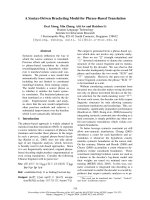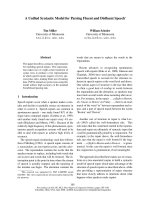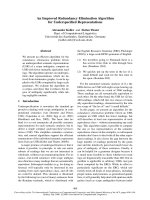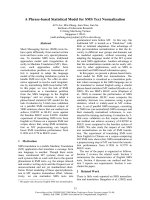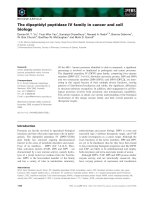báo cáo khoa học: "An evidence-based health workforce model for primary and community care" pot
Bạn đang xem bản rút gọn của tài liệu. Xem và tải ngay bản đầy đủ của tài liệu tại đây (1.19 MB, 8 trang )
DEBATE Open Access
An evidence-based health workforce model for
primary and community care
Leonie Segal and Matthew J Leach
*
Abstract
Background: The delivery of best practice care can markedly improve clinical outcomes in patients with chronic
disease. While the provision of a skilled, multidisciplinary team is pivotal to the delivery of best practice care, the
occupational or skill mix required to deliver this care is unclear; it is also uncertain whether such a team would
have the capacity to adequately address the complex needs of the clinic population. This is the role of needs-
based health workforce planning. The objective of this article is to describe the development of an evidence-
informed, needs-based health workforce model to support the delivery of best-practice interd isciplinary chronic
disease management in the primary and community care setting using diabetes as a case exemplar.
Discussion: Development of the workforce model was informed by a strategic review of the literature, critical
appraisal of clinical practice guidelines, and a consensus elicitation technique using expert multidisciplinary clinical
panels. Twenty-four distinct patient attributes that require unique clinical competencies for the management of
diabetes in the primary care setting were identified. Patient attributes were grouped into four major themes and
developed into a conce ptual model: the Workforce Evidence-Based (WEB) planning model. The four levels of the
WEB model are (1) promotion, prevention, and screening of the general or high-risk population; (2) type or stage
of disease; (3) complications; and (4) threats to self-care capacity. Given the number of potential combinations of
attributes, the model c an account for literally millions of individual patient types, each with a distinct clinical team
need, which can be used to estimate the total health workforce requirement.
Summary: The WEB model was developed in a way that is not only reflective of the diversity in the community
and clinic populations but also parsimonious and clear to present and operationalize. A key feature of the model is
the classification of subpopulations, which gives attention to the particular care needs of disadvantaged groups by
incorporating threats to self-care capacity. The model can be used for clinical, health services, and health workforce
planning.
Background
Disability, morbidity, and mortality associated with
chronic disease continue to reflect the dominant source
of disease burden in Australia [1] and other high-
income countries, and increasingly, in middle-income
countries [2]. There is also well-established evidence
that the delivery of best-practice care can markedly
improve clinical outcomes in patients with chronic dis-
ease [3-5] and that best practice involves skilled, multi-
disciplinary teams [6-9]. But, studies report a
discordance between current clinical practice and best-
practice guidelines, resulting in poorer outcomes,
especially in disadvantaged populations [10,11]. A sup-
portive health infrastructure, adequate health funding
and delivery arrangements, and a health workforce
matched to healthcare needs will be critic al to the deliv-
ery of high-quality chronic disease management. The
development and distribution of c linical best-practice
guidelines is not enough.
Health workforce planning
The demand (or need) for healthcare gives rise to the
demand for the health workforce. Health workforce
planning must therefore be underpinned by an under-
standing of the demand for healthcare. Demand for
healthcare can be defined in one of two ways: (1)
expressed deman d–a market-based concept that reflect s
* Correspondence:
Health Economics and Social Policy Group, Sansom Institute, University of
South Australia, Adelaide, Australia
Segal and Leach Implementation Science 2011, 6:93
/>Implementation
Science
© 2011 Segal and Leach; licensee BioM ed Central Ltd. This is an Open Access article distributed under the terms of the Creative
Commons Attribution License ( which permits unrestricted use, distribution, and
reproduction in any me dium, pr ovided the original work is properly cited.
purchasing decisions of individuals and insurers–or (2)
needs–a more clinically related concept that depends
only on the health status of the population and best-
practice (cost-effective) care.
Expressed demand will only provide a sound basis for
workforce planning where supply and deman d meet (or
at least approxim ate) the conditions of the perfect mar-
ket. But this applies to neither healthcare nor the health
workforce [12] because of constraints on supply (e.g.,
through registration of professions, restrictions on scope
of practice and models of care, and limits on education
and training places) and demand distorted by pervasive
knowledge failures and third-party payment. This means
that expressed demand will not reflect informed consu-
mer preferences and, as such, cannot provide a sound
basis for health workforce planning. Expressed demand
as a basis for health workforce planning is also inconsis-
tent with the a do ption of equity as a health system
objective.
A needs-based approach to demand is the only valid
evidence-based approach to workforce planning. As
noted above, needs in this context relate to the concept
of clinical best practice, as informed by a combination
of effic acy (outcomes in the clinical trial setting), effec-
tivene ss (outcomes in the clinic setting), and cost effec-
tiveness (taking into account costs, value for money, and
budget constraints).
The challenge is to dev elop a workforce model that
reflects the complexity of the community and clinic
population and their needs, is capable of translating
those needs into clinical care requirements, and is tract-
able. This is the challenge addressed by the model
described below.
Before moving to that description, we comment briefly
on the common use of clinician-po pulation ratios for
“workforce planning.” Despite the widespread adoption
of clinician-population ratios (specified for selected
occupations), there is no underlying logic to support
their use and n o evidence offered to support the selec-
tion of a particular ratio as “optimal.” The flaws of this
approach are well described by Birch and colleagues
[13] and other commentators [14].
Emerging approaches to health workforce planning
There is a small emerging literature on health workforce
planni ng that takes a needs-based appr oach, attem pti ng
to address some of the previously mentioned limitations
of health workforce planning. Birch et a l. [13] have
developed an analytical framework for needs-based
health human resources planning, which models the
impact on the health workforce of various assumptions
about the participation rate ofproviders,theirproduc-
tivity or activity rate, and number of training places
[13].Thisisanationalmodelthatspansacrossthe
entire health workforce, which is ideally informed by
detailed local data inputs . There is also promising work
by Andrews et al. [15] with the development of a needs-
based, costed, stepped-care model for mental hea lth ser-
vices. Essentially, their model identifies level of need, the
available treatments, and the st aff and facilities required
to service that need.
While these new approaches to health workforce plan-
ning are promising and represent a considerable
advance on other approaches, they too are not without
limitations. The ne eds-based component of both of
these models essentially assumes the “archetypal”
patient, defined sole ly by the ir primary me dical condi-
tion, which as we have argued elsewhere, is insufficient
for health workforce planning [16]. We therefore sought
to deve lop a health workforce model that could reflect
the diverse nature of the clin ic population and their dis-
tinct healthcare needs, which not only complements the
needs-based approaches to health workforce planning
mentioned previously, but challenges these approaches
to take a richer perspective on population needs.
A new approach to health workforce planning
Segal et al. [17] recently described a needs-based work-
force planning framework for estimating the health
workforce team (i.e., skill mix and hours) required to
support the delivery of best-practice care to a regional
population. In essence, the framework incorporates
three related components that build on each other: (1) a
competency- and skill-based needs assessment, (2) an
estimate of regional service requirements, and (3) policy
implications (see Figure 1). This paper reports on the
findingsfromarecentexercisetooperationalizethe
model through an application to diabetes. The focus
here is with the n eeds assessment, taken to the regional
level.
The needs assessment comprises four stages: (1)
description of the hea lth status of the population, (2)
estimate of the population with defined attributes for
the selected region, (3) collation of evidence regarding
best-practice care for each identified subpopulation, and
(4) translation of best-practice care into care protocols.
Description of the health status of the population
The first activity was to ascertain patient subpopula-
tions/patient attributes that define the need for a unique
clinical team to achi eve best- practice diabetes care. This
was established through a three-stage process:
• A strategic review of the literature, including a cri-
tical appraisal of clinical practice guidelines (CPGs),
to identify patient attributes potentially relevant to
diabetes management. The search was performed
using MEDLINE, EMBASE , and CINAHL , and the
Segal and Leach Implementation Science 2011, 6:93
/>Page 2 of 8
following search terms: diabetes mellitus, gestational
diabetes, health status, health behavior, patient com-
pliance, self-care, self-efficacy, treatment outcome,
type 1 diabetes mellitus, and type 2 diabetes mellitus.
The search was limited to papers published in the
English language after the year 1990, and for which
an abstract was available.
• Discussions with an expert academic panel to iden-
tify additional patient attributes. The panel com-
prised experts in diabetology, diabetes education,
community nursing, dietetics, podiatry, cardiology,
occupational therapy, and public health; all had clini-
cal expertise in managing diabetes.
• Discussions with cross-disciplinary panels of clini-
cians working with patients with diabetes in Metro-
politan Adelaide (South Australia) or the regional
center of Whyalla (South Australia). The aim was to
identify additional subpopulations, as well as seek
confirmation or adjustment to the key patient attri-
butes identified through the prior processes, using a
modified nominal group technique. Essential ly, clini-
cians made comme nts on t he subpopu lations in iso-
lation and without influence from the pa nel. They
then shared their suggestions during the panel meet-
ings and discussed the suggestions presented. Find-
ings were iterated to a point of consensus,
determined by way of voting. Nineteen clinicians,
from 14 disciplines (community nursing, dentistry,
diabetes education, dietetics , endocrinology, exercise
physiology, general practice, occupational therapy,
pharmacy, physiotherapy, podiatry, practice nursing,
public health, and social work), were consu lted dur -
ing this process.
Twenty-four distinct patient attributes, each requiring a
unique occupational and skill mix to manage diabetes in
the primary care setting, were identified through this pro-
cess. Discussions with panel members, and inductive rea-
soning, led to the clustering of these attributes into four
logical and meaningful themes, which were developed into
a conceptual model, hereon referred to as the Workforce
Evidence-Based (WEB) planning model (see Figure 2).
The four themes/levels of the WEB model are (1) pro-
motion, prevention, and screening of the general or
high-risk population; (2) type or stage of disease; (3)
complications; and (4) threats to self-care capacity. Level
1 concerns the health workforce to deliver health pro-
motion and primary and secondary prevention services
for the “at -risk” population. Levels 2 to 4 concern
healthcare needs and the associated health workforce for
persons with the diagnosed condition, in our example,
diabetes mellitus.
Figure 1 Needs-based workforce planning framework. FTE - Full-time equivalent.
Segal and Leach Implementation Science 2011, 6:93
/>Page 3 of 8
The population with diabetes is characterized by type
of diabetes (and whether newly diagnosed) (level 2),
whether they have experienced one or more complica-
tions or events (level 3), and whether they have attri-
butes that suggest specific threats to self-care capacity
(level 4). In this way, a unique set of attributes is
attached to each person that would vary over the course
of the condition and possibly w ith life stages. Given the
number of potential combinations of attributes (our dia-
betes model has five level 2 characteristics, ten level 3,
and nine level 4), the model can account for literally
millions of individual patient types, each with a distinct
occupational and skill mix need, with implications for
total health workforce required.
Estimate of the population with defined attributes for
selected region
Thirteen databases were identified as potentially suitable
for estimating the prevalence of diabete s mellitus and
for subpopulations at the national and regional level. No
single database contained sufficient information to esti-
mate all 24 subpopulations [18]. The largest, most rigor-
ous, and most accessible data source proved to be the
Australian Bureau of Statistics National Health Survey
(2007-2008) [19]; this was selected as the primary data
source to describe population health status. T he
National Health Survey had enough de tail to g enerate
estimates of specific subpopulations, covering type of
diabetes (e.g., type 1, type 2, and gestational diabetes), a
range of complications (e.g., morbid obesity, diagnosed
mental health disorder, eye disease), functional limita-
tions (e.g., impaired physical ability, reduced cognitive
ability), and psychosocial issues (e.g., poor English lan-
guage proficiency, poor mental well-being, substance
abuse, major social/traumatic event, indigenous and eth-
nic background), based on self-report. This was supple-
mented by diabetes-specific data sources, such as the
Australian diabetes, obesity, and lifestyle study (Aus-
Diab) [20-22], hospital admission data [23], and perti-
nent survey/other data [24-34]. Prevalence data for
Figure 2 Workforce Evidence-Based (WEB) model for diabetes, with prevalence data*#. *Data represent the number of cases per 10,000
persons with diabetes, which, based on an estimated prevalence rate of known diabetes of 4% [19], equates to a total population of 250,000
persons. #Prevalence data are derived from the Australian Bureau of Statistics National Health Survey (2007-2008) [19], unless specified otherwise.
a
Australian diabetes, obesity, and lifestyle study (1999/00) [21,22];
b
French, Canadian, German, and U.S. surveys of persons aged 16 years and
older with any type of diabetes [24-28];
c
Amsterdam survey of adults aged 40-94 years with any type of diabetes [29];
d
Australian hospital
admission data [23];
e
U.S. surveys of persons aged 18 years and older with any type of diabetes [30-32];
f
German survey of persons aged 18
years and older with any type of diabetes [33];
g
Australian Bureau of Statistics birth data (2007) [34].
Segal and Leach Implementation Science 2011, 6:93
/>Page 4 of 8
diabetes and for each subpopulation, based on a typical
area/local health service population of 250,000 persons,
are reported in Figure 2, drawing on a combination of
Australian and international data.
Collation of evidence regarding best-practice care for
each identified subpopulation
The original plan was to describe best-practice care for
each subpopulation from CPGs. However, this process
proved problematic. While we identified 27 published
diabetes CPGs that looked suitable for our purpose,
none of the guidelines adequately captured all 24 patient
subpopulations, with most ignoring threats to self-care
capacity (level 4 of the WEB model); even with the com-
bination of guidelines, gaps still remained. The collective
guidelin es of the Canadian Diabetes Ass ociation, Ameri-
can Diabetes Association, and the National Collaborat-
ing Centre fo r Chronic Conditio ns provided adequate
coverage for many s ubpopulations [16]. For the patient
attributes for which CPGs offered limited or no gui-
dance, a consensus of expert opinion was used, employ-
ing the cross-disciplinary panels of clinicians and the
modified nominal group technique described earlier.
Translation of best-practice care into care protocols
Descriptions of best practice (largely defined by objec-
tives of care) were translated into clinical care protocols
(Figure 3)–expressed as the number and duration of
consults by competency and skill level. Initially, it was
expected that this information could be extracted from
CPGs. However, the guidelines rarely contained ade-
quate details to allow the required clinical input to be
ascertained [16]. A decision was therefore made to again
use the collective experiences, opinions, and kno wledge
of the cross-disciplinary panels of clinicians to assist
with the translation of best-practice care into clinical
care protocols and to reach consensus on the protocols
through an iterative process using a modified nominal
group technique (as previously described). The clinical
protocol in effect sits behind each attribute/module.
The care protocols, together with the populat ion esti-
mates for each patient attrib ute, are then fed into phase
two of the workforce model to estimate the regional
demand for each competency ( i.e., hours × competency /
person/year). This is then mapped onto possible occupa-
tions, with alternative ways of delivering defined compe-
tencies m odeled, for example, to reflect a predominant
specialist or generalist approach to service delivery.
More intricate mapping, which take s into consideration
the inherent complexity of translating competencies into
care protocols and occupations (i.e., taking into account
variations in occupational mix and productivity, role
substitution, and the diversity of staff attributes, such as
level of experience, competency), was beyond the scope
of this project. Further work in this area would be valu-
able. The estimation of regional demand is the intended
next step of the project, with findings expected to be
published soon.
Discussion
The WEB model, which emerged as an essential compo-
nent of the needs analysis, presents a new and effective
way of approaching health workforce planning. The
modular structure allows differe nt components of care
to be easily added or omitted according to the charac-
teristics or attributes of the population, best-practice
care, evidence of cost effectiveness, and changes in the
understanding of disease and threats to successful treat-
ment. Also, because the care protocols within each
module/subpopulation are competency-based, it can
easily accommodate emerging service providers and the
modelling of alternative delivery methods.
The WEB model has clear implications for the desir-
able composition of the multidisciplinary team. In parti-
cular, occupations that are trained to deliver
competencies pertinent to level 4 (threats to self-care),
such as social work, occupational therapy, or mental
health workers, are more likely to be identified as core
members of the primary care team. An evidence-based
approach to est ablishing the desirable mix of the multi-
disciplinary team, and us ing that for service planning, is
fundamental to the delivery of high-quality care in
which knowledge can be translated into clinical practice
for the benefit of the patient.
An unexpected benefit of the WEB model i s its diver-
sity of application. While the model was primarily
designed to guide health workforce planning, health ser-
vices planning, and funding that reflects care needs, it
also provides a useful framework to direct group discus-
sion and workshops around chronic disease manage-
ment and to identify pertinent gaps in data and
research. For instance, it has already highlighted impor-
tant limitations in the production of CPGs and the evi-
dence base o n which they are drawn [16]. The WEB
model may also benefit clinicians by providing a new
way of thinking about the d elivery of individualized
clinical care and provide a framework for health
screening.
There are several challenges to implementation of the
WEB model. One challenge relates to the quality of data
inputs. Determining the level of service need in complex
patients is also problematic. Even where it is possible to
define with strong agreement the management require-
ments for each subpopulation, questions still remain
about how to combine workforce and service needs
acr oss attributes, within and between levels. The expec-
tation is that a simple additive approach will be applic-
able across levels, as each level deals with quite distinct
Segal and Leach Implementation Science 2011, 6:93
/>Page 5 of 8
types of needs. However, within a level, recognizing that
clinicians can cover more than one issue during a con-
sultation (where these are related), the protocol is to
adopt the conservative position of taking the highest
value (of consultation time) for the competency at that
level (and not add across attributes). The result will be a
minimum estimate of workforce and service need. Com -
bining up to an entire primary and communi ty care
chronic disease team, which is the ultimate aim, adds an
extra level of complexity, reflecting the genuine chal-
lenges of this research/policy question.
We are confident that the w orkforce planning frame-
work and the WEB model can be usefully applied to
other groups of conditions, such as cardiovascular dis-
ease, mental health disorders, or musculoskeletal disor-
ders, recognizing that some modification to the
structure, levels, and attributes may be required. Discus-
sions with health workforce planning agencies have
Figure 3 Example of a clinical care protocol–the “impaired physical ability” module of the WEB model.
Segal and Leach Implementation Science 2011, 6:93
/>Page 6 of 8
confirmed the value of the model for those seeking an
evidence-based approach to health workforce and health
services planning. The South Australian Department of
Health is already using the WEB model to inform the
planning of state-wide pediatric speech pathology ser-
vices and the state’s palliative care workforce.
Summary
This paper discusses our l earnings from the operationa-
lization of a needs-based workforce planning framework.
The WEB mode l, a major output of this work, offers a
means for incorporating the diversity of the clin ic popu-
lation while retaining simplicity of design. This work
represents a critical step in the development of a work-
force model that reflects the complexity of the commu-
nity population and their needs.
The composition of the multidisciplinary team that
arises out of application of this model is very different to
that which emerges under a more narrow medical condi-
tion focus; for example, social work is identified as a core
competency in the primary care team. By incorporating
threats to self-care into the model, and into health work-
force and health services planning, the model offers the
promise of a service system better able to serve the needs
of groups who are disadvantaged, who undoubtedly are
disadvantaged under planning models that focus on the
archetypal, generally high-functioning patient. The ulti-
mate promi se is better health outcomes for all, including
a reduction in avoidable health deficits for persons with
multiple disadvantages.
Acknowledgements
The authors would like to sincerely thank all members of the expert clinical
panels for their valuable contribution to the project, particularly the ongoing
support provided by Dr. Pat Phillips (endocrinologist, Queen Elizabeth
Hospital), Ms. Jane Giles (credentialed diabetes educator, Queen Elizabeth
Hospital), Mrs. Connie Stanton (accredited practicing dietician, Queen
Elizabeth Hospital), Mrs. Denise McKenzie (practice nurse, Adelaide Western
division of general practice), Mrs. Julianne Badenoch (president, Australian
Practice Nurses’ Association), Mrs. Helen Edwards (diabetes counsellor/social
worker, diabetes counselling online), Ms. Catherine Turnbull (social worker/
allied health advisor, South Australian Department of Health), and Professor
Esther May (Dean of Health and Clinical Education, University of South
Australia).
This project is funded by an Australian Research Council Linkage grant
(LP0883955). The funders had no role in study design, data collection and
analysis, decision to publish, or preparation of the manuscript.
Authors’ contributions
LS and MJL contributed equally to the writing of the manuscript, from
conception to submission. Both authors read and approved the final
manuscript.
Competing interests
The authors declare that they have no competing interests.
Received: 29 March 2011 Accepted: 6 August 2011
Published: 6 August 2011
References
1. Australian Institute of Health & Welfare (AIHW): Chronic diseases and
associated risk factors in Australia, 2006. Cat. No. PHE 81 Canberra, Australia:
AIHW; 2006.
2. World Health Organisation: The global burden of disease: 2004 update
Geneva, Switzerland: World Health Organization; 2008.
3. Hepner KA, Rowe M, Rost K, Hickey SC, Sherbourne CD, Ford DE,
Meredith LS, Rubenstein LV: Improving patient care: the effect of
adherence to practice guidelines on depression outcomes. Ann Intern
Med 2007, 147:320-329.
4. Komajda M, Lapuerta P, Hermans N, Gonzalez-Juanatey JR, van
Veldhuisen DJ, Erdmann E, Tavazzi L, Poole-Wilson P, Le Pen C: Adherence
to guidelines is a predictor of outcome in chronic heart failure: the
MAHLER survey. Eur Heart J 2005, 26:1653-1659.
5. Varga D, Wischnewsky M, Atassi Z, Wolters R, Geyer V, Strunz K,
Kreienberg R, Woeckel A: Does guideline-adherent therapy improve the
outcome for early-onset breast cancer patients? Oncology 2010,
78:189-195.
6. Ettner SL, Kotlerman J, Afifi A, Vazirani S, Hays RD, Shapiro M, Cowan M: An
alternative approach to reducing the costs of patient care? A controlled
trial of the multi-disciplinary doctor-nurse practitioner (MDNP) model.
Med Decis Making 2006, 26:9-17.
7. Hemmelgarn BR, Manns BJ, Zhang J, Tonelli M, Klarenbach S, Walsh M,
Culleton BF: Association between multidisciplinary care and survival for
elderly patients with chronic kidney disease. J Am Soc Nephrol 2007,
18:993-999.
8. Inglis SC, Pearson S, Treen S, Gallasch T, Horowitz JD, Stewart S: Extending
the horizon in chronic heart failure: Effects of multidisciplinary, home-
based intervention relative to usual care. Circulation 2006, 114:2466-2473.
9. Kim MM, Barnato AE, Angus DC, Fleisher LF, Kahn JM: The effect of multi-
disciplinary care teams on intensive care unit mortality. Arch Intern Med
2010, 170:369-376.
10. Rittenhouse DR, Shortell SM, Gillies RR, Casalino LP, Robinson JC,
McCurdy RK, Siddique J: Improving Chronic Illness Care: Findings from a
national study of care management processes in large physician
practices. Med Care Res Rev 2010, 67:301-320.
11. McDermott RA, Tulip F, Schmidt B: Diabetes care in remote northern
Australian Indigenous communities. Med J Aust 2004, 180:512-516.
12. McGuire A, Henderson J, Mooney G: The economics of health care: an
introductory text London, England: Routledge & Kegan Paul; 1988.
13. Birch S, Kephart G, Murphy GT, O’Brien-Pallas L, Alder R, MacKenzie A:
Health human resources planning and the production of health:
development of an extended analytical framework for needs-based
health human resources planning. J Public Health Management Practice
2009, 15:S56-S61.
14. Weiner JP: Expanding the US medical workforce: global perspectives and
parallels. Brit Med J 2007, 335:236-235.
15. Andrews G, Tolkien II team: Tolkien II: a needs-based, costed, stepped-care
model for mental health services Sydney, Australia: World Health
Organization Collaborating Centre for Classification in Mental Health; 2007.
16. Leach MJ, Segal L: Are
clinical practice guidelines (CPGs) useful for health
services and health workforce planning? A critique of diabetes CPGs.
Diabetic Med 2010, 27:570-577.
17. Segal L, Dalziel K, Bolton T: A workforce model to support the adoption
of best practice care in chronic diseases - a missing piece in clinical
guidelines implementation. Implementation Science 2008, 3:35.
18. Leach MJ, Segal L: Population estimates of people with diabetes mellitus.
[ />asp].
19. Australian Bureau of Statistics: 2007-2008 National health survey: summary of
results [Cat. No. 4364.0] Canberra, Australia: Australian Bureau of Statistics;
2009.
20. Dunstan D, Zimmet P, Welborn T, de Courten M, Cameron A, Sicree R,
Dwyer T, Colagiuri S, Jolley D, Knuiman M, Atkins R, Shaw J: The rising
prevalence of diabetes and impaired glucose tolerance. Diabetes Care
2002, 25:829-834.
21. Tapp R, Shaw J, de Courten M, Dunstan D, Welborn T, Zimmet P: Foot
complications in type 2 diabetes: An Australian population-based study.
Diab Med 2003, 20:105-13.
Segal and Leach Implementation Science 2011, 6:93
/>Page 7 of 8
22. Atkins RC, Polkinghorne KR, Briganti EM, Shaw JE, Zimmet PZ, Chadban SJ:
Prevalence of albuminuria in Australia: The AusDiab kidney study. Kidney
Intern 2004, 66:S22-S24.
23. Australian Institute of Health and Welfare (AIHW): Cardiovascular disease:
Australian facts 2011 [Cat. No. CVD 53] Canberra, Australia: AIHW; 2011.
24. Enzlin P, Mathieu C, Van den Bruel A, Vanderschueren D, Demyttenaere K:
Prevalence and predictors of sexual dysfunction in patients with type 1
diabetes. Diab Care 2003, 26:409-414.
25. Fitzgerald MP, Link CL, Litman HJ, Travison TG, McKinlay JB: Beyond the
lower urinary tract: the association of urologic and sexual symptoms
with common illnesses. Europ Urol 2007, 52:407-415.
26. Giuliano FA, Leriche A, Jaudinot EO, De Gendre AS: Prevalence of erectile
dysfunction among 7689 patients with diabetes or hypertension, or
both. Urology 2004, 64:1196-1201.
27. Grover SA, Lowensteyn I, Kaouache M, Marchand S, Coupal L, de Carolis E,
Zoccoli J, Defoy I: The prevalence of erectile dysfunction in the primary
care setting: importance of risk factors for diabetes and vascular disease.
Arch Intern Med 2006, 166:213-219.
28. Schiel R, Muller UA: Prevalence of sexual disorders in a selection-free
diabetic population (JEVIN). Diab Res Clin Prac 1999, 44:115-121.
29. de Sonnaville JJ, Colly LP, Wijkel D, Heine RJ: The prevalence and
determinants of foot ulceration in type 2 diabetic patients in a primary
health care setting. Diab Res Clin Prac 1997, 35:149-56.
30. Kim S, Love F, Quistberg DA, Shea JA: Association of health literacy with
self-management behaviour in patients with diabetes. Diab Care 2004,
27:2980-2982.
31. Morris NS, MacLean CD, Littenberg B: Literacy and health outcomes: a
cross-sectional study of 1002 adults with diabetes. BMC Family Practice
2006, 7:49-56.
32. Williams MV, Baker DW, Parker RM, Nurss JR: Relationship of functional
health literacy to patients’ knowledge of their chronic disease. A study
of patients with hypertension and diabetes. Arch Intern Med 1998,
158:166-172.
33. Herpertz S, Wagener R, Albus C, Kocnar M, Wagner R, Best F,
Schleppinghoff BS, Filz HP, Förster K, Thomas W, Mann K, Köhle K, Senf W:
Diabetes mellitus and eating disorders: a multicenter study on the
comorbidity of the two diseases. J Psychosom Res 1998, 44:503-515.
34. Australian Bureau of Statistics: Births, Australia, 2007 [Cat. No. 3301.0]
Canberra, Australia: Australian Bureau of Statistics; 2008.
doi:10.1186/1748-5908-6-93
Cite this article as: Segal and Leach: An evidence-b ased health
workforce model for primary and community care. Implementation
Science 2011 6:93.
Submit your next manuscript to BioMed Central
and take full advantage of:
• Convenient online submission
• Thorough peer review
• No space constraints or color figure charges
• Immediate publication on acceptance
• Inclusion in PubMed, CAS, Scopus and Google Scholar
• Research which is freely available for redistribution
Submit your manuscript at
www.biomedcentral.com/submit
Segal and Leach Implementation Science 2011, 6:93
/>Page 8 of 8


